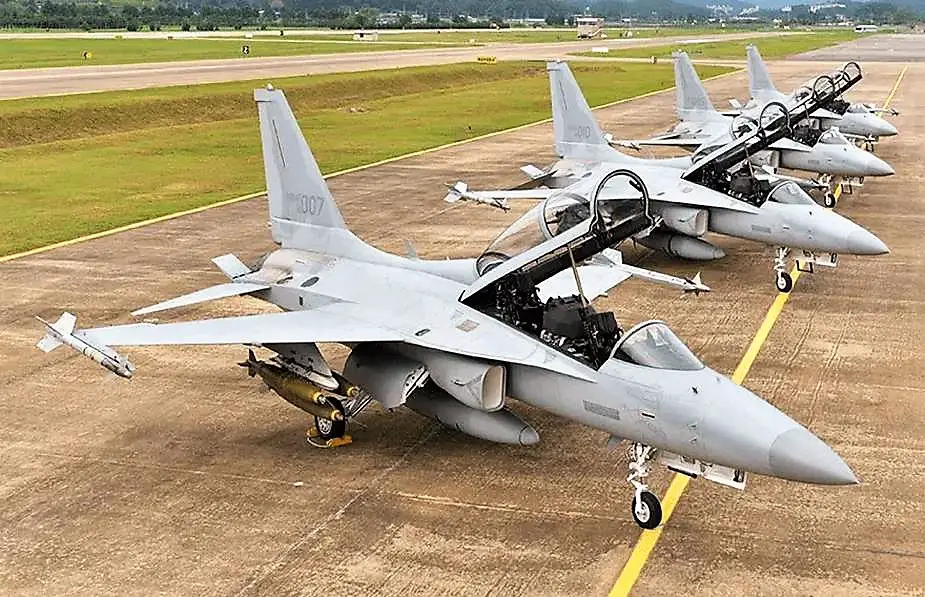The Malaysian Ministry of Defence has signed a final contract for the acquisition of 18 FA-50 Block 20 light combat aircraft for the Royal Malaysian Air Force (RMAF) from South Korean aviation company Korea Aerospace Industries (KAI), Asia Pacific Defense Journal reported on May 29, 2023. The contract worth US$920 million was signed at the backdrop of the recently concluded Langkawi International Maritime & Aerospace Exhibition 2023 (LIMA 2023) in Langkawi, Malaysia on 23 May 2023.
Follow Air Recognition on Google News at this link

KAI FA-50 Fighting Eagle LCA (Light Combat Aircraft) (Picture source: ROKAF)
The FA-50 Block 20 is described as the most advanced variant of the FA-50 Fighting Eagle light combat aircraft, with Poland being the only other confirmed buyer of the type. Compared to earlier variants of the FA-50, the Block 20 features a more advanced Raytheon PhantomStrike AESA radar, an aerial refuelling capability from Chobham, and is capable of carrying and operating the Sniper advanced targeting pod(ATP), and ability to fire more munition types including beyond visual range air-to-air missiles (BVRAAM) and stand-off missiles.
Part of the deal also includes the final assembly of 14 aircraft in Malaysia under the Industrial Collaboration Programme (ICP) between Malaysia and South Korea. KAI will provide the necessary raw materials and key components to be used on the locally assembled aircraft. The FA-50 Block 20 will replace the Hawk 100 and 200 series lead-in fighter trainers and light combat aircraft, as well as the Aermacchi MB.339 advanced jet trainers. The RMAF is expected to receive the first aircraft by October 2026, which will make Malaysia the fourth Southeast Asian country to operate the type after Indonesia, the Philippines and Thailand.
The KAI FA-50 Block 20 is a versatile multirole fighter aircraft developed by Korea Aerospace Industries (KAI). It is an advanced variant of the FA-50, which itself is a light combat aircraft derived from the successful T-50 Golden Eagle trainer aircraft. The Block 20 represents the latest iteration of this platform, incorporating several enhancements and upgrades over its predecessors.
In terms of design, the FA-50 Block 20 retains the sleek and aerodynamic profile of its predecessors. It features a single-engine, low-wing configuration with a streamlined fuselage and a tandem two-seat cockpit. The aircraft is constructed using advanced composite materials, allowing for increased strength and reduced weight.
The FA-50 Block 20 is powered by a single General Electric F404-102 turbofan engine, which provides it with a high thrust-to-weight ratio and excellent maneuverability. This engine enables the aircraft to achieve a maximum speed of Mach 1.5 (approximately 1,850 km/h) and a service ceiling of around 14,600 meters. It has a maximum range of approximately 2,700 km.
One of the key features of the FA-50 Block 20 is its advanced avionics suite, which includes a modern glass cockpit and a wide range of sensors and systems. The aircraft is equipped with a multifunction radar, an electronic warfare suite, an infrared search and track (IRST) system, and a helmet-mounted display (HMD) for improved situational awareness. These advanced avionics enable the pilot to effectively engage targets in various environments and conduct both air-to-air and air-to-ground missions.
The FA-50 Block 20 also boasts an impressive weapon payload capacity. It can carry a variety of air-to-air missiles, air-to-surface missiles, precision-guided munitions, and rockets. It is capable of conducting close air support, interdiction, air defense, and counter-air operations. The aircraft is also equipped with an internal 20mm Gatling gun for strafing ground targets.
Furthermore, the FA-50 Block 20 has been enhanced with improved electronic warfare capabilities, upgraded mission computers, and a modernized data link system for enhanced communication and data sharing with other platforms. These upgrades significantly enhance the aircraft's overall combat effectiveness and interoperability.
















